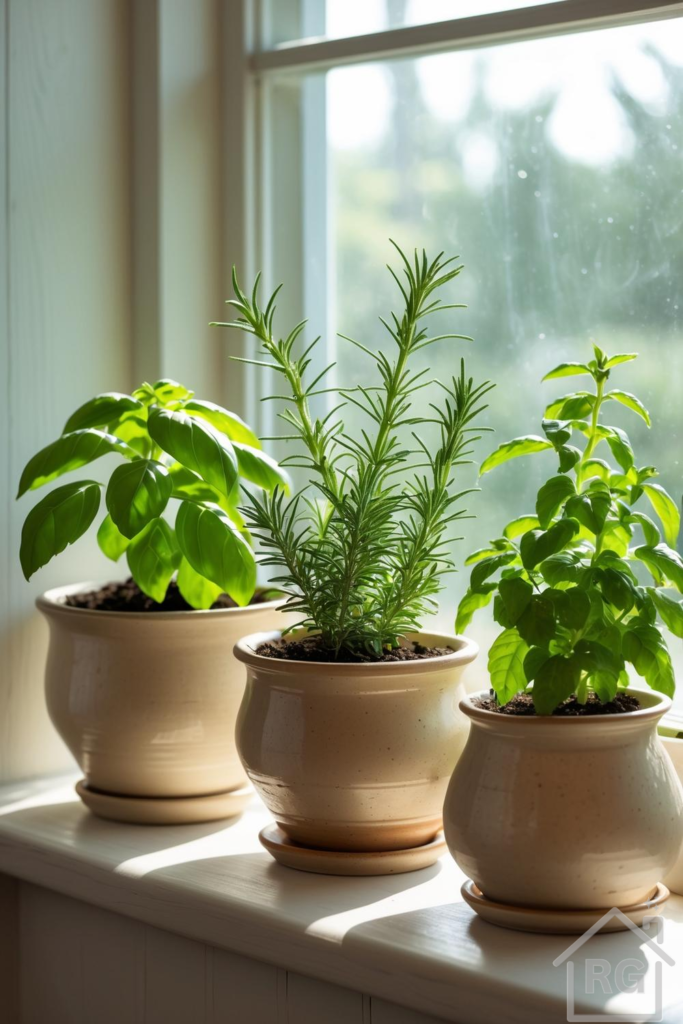
Why Start a Windowsill Herb Garden? Freshness at Your Fingertips
Imagine stepping into your kitchen and being greeted by the fresh, earthy scent of basil or the invigorating aroma of rosemary. A windowsill herb garden is more than just a charming decorative element; it’s a living pantry, a source of vibrant greenery, and a simple pleasure that brings the outdoors in.
This guide will walk you through everything you need to know to cultivate a thriving herb garden right on your windowsill, transforming a simple space into a fragrant, functional, and beautiful corner of your home.
The beauty of a windowsill herb garden lies in its accessibility. Even if you lack a sprawling backyard or a dedicated garden plot, a sunny window is all you need to start enjoying fresh herbs year-round. Beyond the culinary benefits, these miniature green spaces contribute to a sense of well-being, purify the air, and add a touch of natural elegance to any interior.
Choosing Your Herbs Wisely: Aromatic Companions for Your Home
The first step to a successful windowsill garden is selecting the right herbs. Consider your culinary preferences, but also the specific needs of each plant. Some herbs are more forgiving for beginners, while others require a bit more attention.
- Basil: With its broad, bright green leaves and sweet, peppery flavor, basil is a kitchen staple. It loves warmth and plenty of sunlight. Keep the soil consistently moist but not waterlogged. Pinch off flowers to encourage leaf growth.
- Rosemary: This woody, fragrant herb with its needle-like, deep green leaves is incredibly versatile. Rosemary thrives in bright light and well-draining soil. It prefers to dry out slightly between waterings.
- Mint: Known for its vigorous growth and refreshing aroma, mint comes in many varieties (peppermint, spearmint, chocolate mint). It’s quite adaptable but can be invasive, so it’s best kept in its own pot. Mint enjoys consistent moisture and partial to full sun.
- Chives: These delicate, onion-flavored greens are easy to grow and add a mild zest to dishes. Chives prefer full sun and moist, well-drained soil. They can be harvested frequently.
- Thyme: A low-growing, hardy herb with tiny, aromatic leaves. Thyme prefers plenty of sunlight and well-draining soil, tolerating drier conditions once established.
- Oregano: Similar to thyme, oregano is a robust herb that thrives in full sun and prefers drier soil. Its pungent flavor is a cornerstone of Mediterranean cuisine.
When choosing, consider the mature size of the plant and how much space you have. A mix of upright and trailing herbs can create a visually appealing display.
Selecting the Perfect Pots: Form Meets Function
The right container is crucial for the health and aesthetic of your herb garden. Look for pots that are not only beautiful but also functional.
- Material:
- Ceramic or Terracotta: These natural materials, often in warm beige or earthy tones, are excellent choices. They are porous, allowing for good air circulation to the roots and helping to prevent overwatering. The classic, slightly rustic look of these pots complements the natural beauty of the herbs.
- Plastic: Lightweight and inexpensive, plastic pots retain moisture longer, which can be beneficial for some herbs but requires careful watering to avoid root rot.
- Metal: While stylish, metal pots can heat up quickly in direct sunlight, potentially stressing the roots.
- Drainage: This is non-negotiable. Every pot must have drainage holes at the bottom to prevent water from pooling and causing root rot. Use saucers underneath to catch excess water and protect your windowsill. Consider pots with matching saucers for both style and practicality.
- Size: Choose pots that are appropriately sized for your herbs. Young plants can start in smaller pots, but as they grow, they’ll need more room for their roots to expand. A general rule of thumb is to select a pot that’s at least 6 inches in diameter for most herbs.
The Importance of Light: Fueling Your Greenery
Light is the most critical factor for a successful windowsill herb garden. Most herbs require at least 6 hours of direct sunlight per day to thrive.
- South-Facing Windows: These are typically the best spots, offering the most intense and prolonged sunlight throughout the day.
- East-Facing Windows: Provide gentle morning sun, which is good for herbs that prefer slightly less intense light or for supplementing a south-facing window.
- West-Facing Windows: Offer strong afternoon sun, which can be quite hot. Monitor your herbs for signs of scorching.
- North-Facing Windows: Generally provide insufficient light for most herbs, though some low-light tolerant plants might survive.
If your natural light is insufficient, consider supplementing with a grow light. LED grow lights are energy-efficient and can provide the full spectrum of light your herbs need, especially during shorter winter days. Position them a few inches above your plants.
Watering Wisdom: The Art of Hydration
Proper watering is key to healthy herbs. Overwatering is a common killer of indoor plants, leading to root rot.
- Feel the Soil: Don’t water on a strict schedule. Instead, stick your finger about an inch or two into the soil. If it feels dry, it’s time to water. If it’s still damp, wait.
- Water Thoroughly: When you do water, do so until water drains out of the bottom of the pot. This ensures that the entire root ball is moistened. Empty any excess water from the saucer after about 15-20 minutes.
- Consider Herb Needs: Some herbs, like basil and mint, prefer consistently moist soil, while others, like rosemary and thyme, prefer to dry out slightly between waterings. Adjust your routine accordingly.
- Humidity: Indoor air can be dry, especially in winter. Misting your herbs occasionally or placing their pots on a pebble tray filled with water can increase humidity around them.
Feeding and Pruning for Success: Nurturing Growth
To keep your herbs productive and bushy, a little feeding and regular pruning go a long way.
- Fertilizing: Herbs don’t need heavy feeding. A diluted liquid fertilizer (half-strength) every 2-4 weeks during the growing season (spring and summer) is usually sufficient. Avoid fertilizing in fall and winter when growth slows.
- Pruning and Harvesting: Regular harvesting encourages your herbs to produce more foliage and prevents them from becoming leggy or going to seed too quickly.
- For basil, pinch off the top sets of leaves just above a node (where two leaves meet) to encourage bushier growth.
- For rosemary, snip off sprigs as needed, taking care not to remove more than a third of the plant at once.
- Always use clean, sharp scissors or pruners to avoid damaging the plant.
Designing Your Edible Display: Aesthetics and Arrangement
Beyond functionality, your windowsill herb garden can be a beautiful focal point.
- Varying Heights and Textures: Combine herbs with different growth habits and leaf textures. For instance, the broad, smooth leaves of basil contrast beautifully with the fine, needle-like foliage of rosemary.
- Pot Selection: Using matching or complementary pots creates a cohesive and polished look. The warm, creamy beige of the ceramic pots provides a lovely neutral base that allows the vibrant greens of the herbs to truly pop.
- Arrangement: Grouping pots together creates a fuller, more impactful display. You can arrange them symmetrically or create an asymmetrical, organic flow. Consider placing taller herbs at the back and shorter ones in front if viewed from multiple angles.
- Cleanliness: Keep your windowsill clean and free of debris. Wipe down the pots and saucers regularly. This not only looks better but also helps prevent pests.
- Adding Decorative Elements: While the focus is on the herbs, you can subtly enhance the display. A small decorative stone, a charming plant marker, or even a small watering can placed nearby can add character without cluttering the space.
Troubleshooting Common Issues: Keeping Your Herbs Happy
Even with the best care, you might encounter some challenges. Here are common issues and how to address them:
- Yellowing Leaves: Often a sign of overwatering or nutrient deficiency. Check soil moisture first. If dry, water. If wet, let it dry out. Consider a diluted fertilizer if it’s been a while.
- Leggy Growth: This indicates insufficient light. Move your herbs to a brighter spot or supplement with a grow light. Regular pruning also helps promote bushier growth.
- Pests: Common indoor pests include aphids, spider mites, and whiteflies. Inspect your plants regularly. If you spot pests, gently wipe them off with a damp cloth or use an insecticidal soap specifically designed for edible plants.
- Wilting: Can be due to both under- and overwatering. Check the soil moisture. If dry, water thoroughly. If wet, allow it to dry out.
Beyond the Kitchen: Other Ideal Spots for Your Herbs
While the kitchen windowsill is the classic spot, don’t limit yourself! Many herbs can thrive in other areas of your home:
- Bathroom: Herbs like mint and rosemary can enjoy the humidity of a bathroom, provided there’s enough light.
- Home Office: The fresh scent of herbs can be invigorating and help improve focus, making your workspace more pleasant.
- Bedroom: Lavender, while not typically a culinary herb, is known for its calming properties and can thrive on a sunny bedroom windowsill, promoting relaxation.
Embrace the Green: Your Journey to a Thriving Herb Garden
Creating a windowsill herb garden is a rewarding endeavor that brings life, aroma, and flavor into your home. From the initial joy of selecting your favorite herbs and finding the perfect creamy beige pots, to the daily ritual of watering and the satisfaction of harvesting your own fresh ingredients, every step is a connection to nature.
Embrace the process, learn from your plants, and soon you’ll be enjoying the vibrant beauty and delicious bounty of your very own indoor herb garden. It’s a simple addition that yields immense pleasure and transforms an ordinary window into a living, breathing testament to natural beauty and sustainable living.
